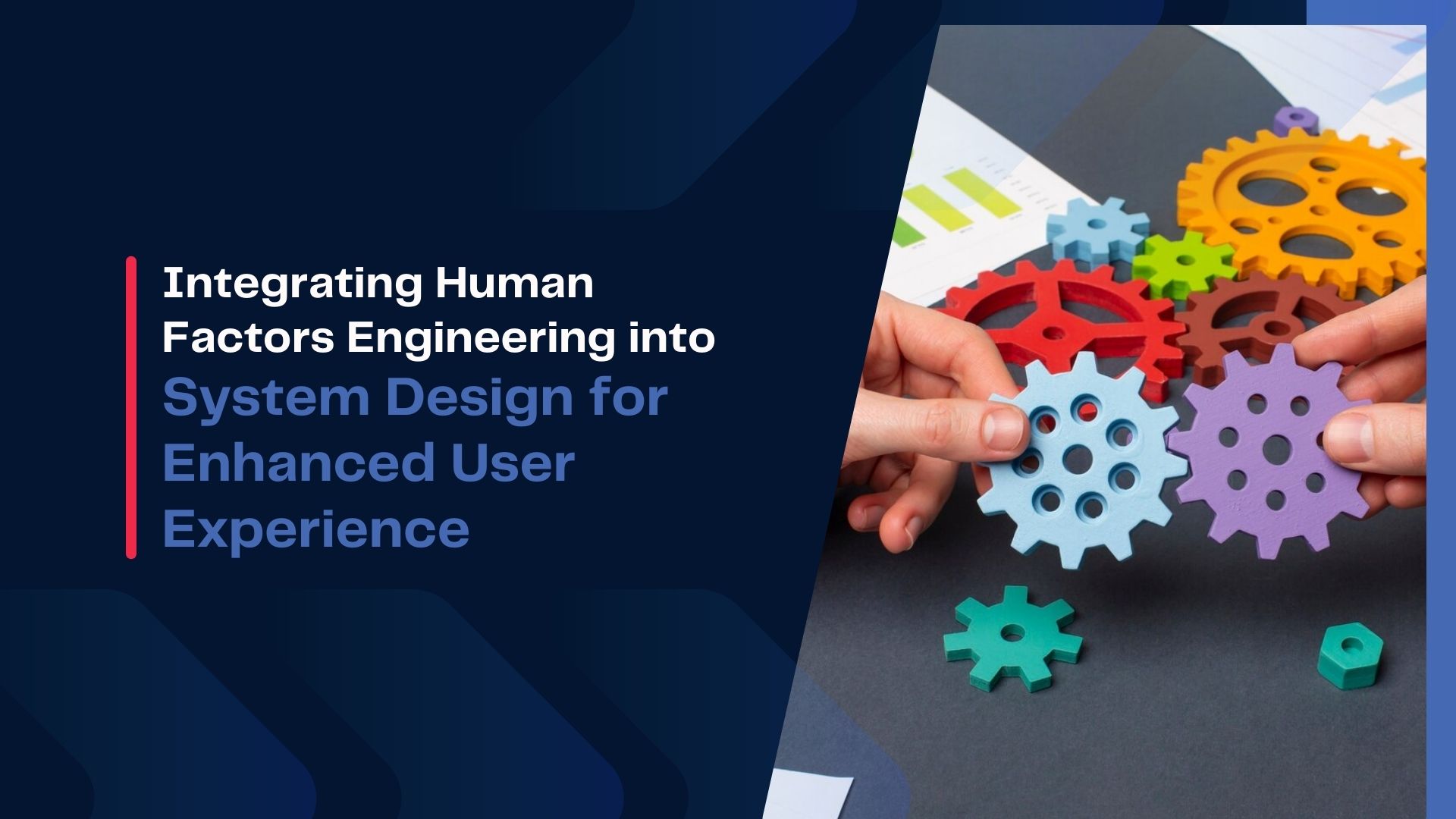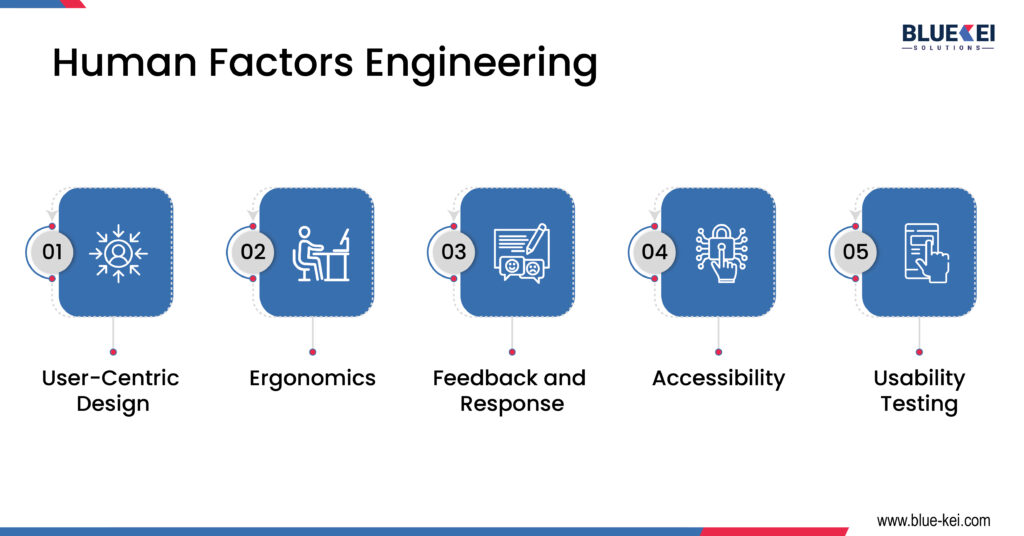Integrating Human Factors Engineering into System Design for an Enhanced User Experience
In a world driven by swift technological breakthroughs, two systems set out on a journey: a Decision-Making System and a System aimed to benefit humanity. Their objective was to figure out the secrets of the other, Human Factors Engineering (HFE), and incorporate them into the very fabric of their being. This goal was more than just about improving functionality; it was about making the user experience more intuitive, inclusive, and truly human.

As they journeyed through the landscapes of design and user interaction, they encountered a startling truth, that up to 75% to 80% of usability issues in products and systems are often attributed to a disregard for human factors? This revelation became a guiding light, illuminating the path toward understanding the critical importance of HFE.
HFE, with its focus on areas such as ergonomics, cognitive workload, and user interface design, offered the key to minimizing errors, boosting efficiency, and elevating user satisfaction. The systems realized that in the face of relentless technological progress and ever-evolving user demands, the relevance of HFE was more vital than ever.
By tailoring their designs to align with human capabilities and limitations, the systems discovered the transformative power of HFE. It was not just a methodology but a pivotal force in shaping user experiences, ensuring that their interactions were not only efficient but also resonated on a human level.
This blog post delves into the intricate relationship between HFE and system design, underscoring its significant impact on achieving unprecedented levels of user satisfaction.
The Encounter
The Decision-Making System (DMS) was crafted to optimize operations and make choices rooted in logic and data. Yet, as it grew in complexity, it realized that its design was becoming increasingly detached from those it was meant to serve—the users. Frustrated by a growing disconnect, DMS sought counsel from the System utilizing Human Factors Engineering (HFE System), an entity renowned for its deep understanding of human needs.
The HFE System explained, “Your algorithms are accurate, your reasoning flawless, but you ignore the fundamental essence of what it means to be human. Up to 80% of usability issues stem from a failure to consider the complexities of human experience. If we are to fulfill our mission, we must close the gap between our technological capabilities and the real-world experiences of individuals who use us.

Bridging the Gap
As they journeyed together, DMS began to grasp the essence of HFE. The HFE System demonstrated how it meticulously studied human interactions with technology, focusing on ergonomics, cognitive workload, and user interface design. Through this lens, DMS learned to tailor its processes, ensuring they aligned with human capabilities and limitations.
“Look,” said the HFE System, “Here, in the development of complex systems like medical devices and aviation controls, we’ve reduced the risk of human error by understanding how people think and react. Our designs don’t just function—they resonate with users on a fundamental level.”
DMS observed as the HFE System iteratively tested and refined its interfaces, using real-world scenarios to gather feedback. This iterative process was like a symphony, each note carefully tuned to create a harmonious experience for users.
Empathy in Design
DMS realized that empathy was the cornerstone of exceptional design. The HFE System guided it through user research, revealing the subtle nuances of user preferences, pain points, and behaviors. “To truly serve,” the HFE System explained, “we must first understand. We must step into the user’s shoes and view the world through their eyes.”
As DMS began to empathize with the people it serves, its design choices transformed. It was no longer just about efficiency; it was also about providing an experience that spoke to the individual. Each decision was now guided by a thorough grasp of the human experience, which fostered trust and long-term relationships.
Simplifying Complexity
One of the most profound lessons DMS learned was the power of simplicity. The HFE System emphasized the importance of reducing cognitive load, simplifying complex systems so that users could interact with them effortlessly.
“Information overload is our enemy,” the HFE System cautioned. “We must present information in a way that is digestible, prioritizing key elements and breaking down tasks into manageable pieces. This way, users can engage with our systems without frustration or confusion.”
DMS adopted those principles by redesigning its interfaces to be more natural, employing techniques such as chunking and visual hints to effortlessly assist users through various tasks.
Ergonomics and Physical Comfort
The journey continued, and DMS was introduced to the art of ergonomics. The HFE System explained how physical comfort directly impacted user experience. “From the layout of a keyboard to the placement of buttons,” it said, “every detail must align with human anatomy and biomechanics.”
DMS observed how the HFE System meticulously optimized every physical interaction, ensuring that users could engage with technology without strain or discomfort. This attention to physical ergonomics not only enhanced user satisfaction but also boosted productivity.
Fostering Engagement
As DMS grew more attuned to HFE principles, it began to appreciate the importance of feedback and responsive design. The HFE System showed how even the subtlest of animations or notifications could keep users engaged and informed.
“Communication is key,” the HFE System explained. “Our users must feel connected to us, knowing that we respond to their actions and guide them with clarity. This fosters a dynamic and interactive relationship, one where users feel empowered and in control.”
Embracing Accessibility
Inclusivity became the next focus of their journey. The HFE System introduced DMS to the concept of designing for all users, regardless of their abilities. “Accessibility isn’t just a feature,” the HFE System said, “it’s an imperative. We must ensure that everyone, regardless of their physical or cognitive capabilities, can interact with us effortlessly.”
DMS learned to incorporate accessibility features like screen readers, voice commands, and alternative input methods, ensuring that its design was as inclusive as possible.
Iterative Refinement
As their journey neared its end, DMS understood that the pursuit of perfection was an ongoing process. The HFE System emphasized the importance of usability testing—a cycle of continuous refinement based on real-world user feedback.
“Perfection is not a destination,” the HFE System said. “It’s a journey of iterative refinement. We observe, we learn, we adapt. This is how we evolve, ensuring that our designs remain relevant and effective.”
An Exciting Future
With newfound wisdom, DMS and the HFE System wrapped up their journey. Together, they had altered the user experience into something more profound and human. The systems they created were more than just tools; they were companions who blended seamlessly into the lives of people they served.
As they looked into the future, they were confident that the principles of Human Factors Engineering would continue to guide them. In a world where technology and people were becoming increasingly entwined, their dedication to user-centered design would ensure that they remained not only relevant, but necessary.
With confidence in their potential to build a future where technology genuinely served people, enhancing lives and empowering users globally, they set out on their next journey, ready to take on whatever challenges awaited their way.
We saw how businesses benefit from the systems engineering approach. There is much to explore and achieve. You may also want to reap the benefits of this approach. Let BlueKei help your organization leverage systems engineering to its full potential. Contact us to schedule a call to get things going!
If you are interested in understanding how to adopt systems engineering and model based systems engineering practices within your organization, reach out to BlueKei Solutions team at info@Blue-Kei.com. We specialize in systems engineering consulting, project executions, process adoptions such as compliance to ISO15288, ARP 4754A, ISO 42020, digital transformations. We can also conduct capability development workshops which are experiential and tailored to your needs. With systems engineering adoption you can address the complexity, manage evolving risks and bring transformation in communication within your organization through digitalization and create the digital thread.
Post Views: 3,036

